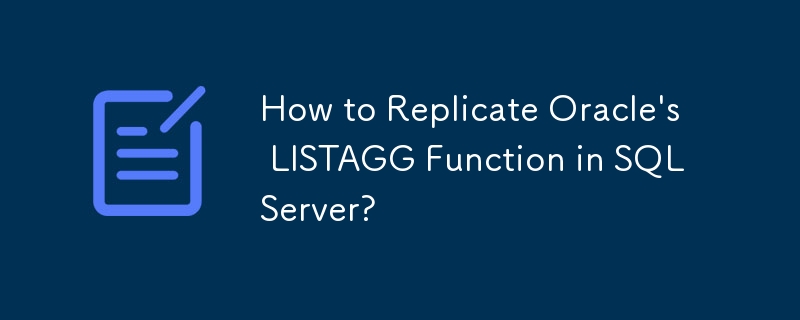How to Replicate Oracle's LISTAGG Function in SQL Server?

Simulating Oracle’s LISTAGG function in SQL Server
SQL Server itself does not contain the LISTAGG function, but similar functions can be achieved through various methods.
MySQL
SELECT FieldA, GROUP_CONCAT(FieldB ORDER BY FieldB SEPARATOR ',') AS FieldBs FROM TableName GROUP BY FieldA ORDER BY FieldA;
Oracle & DB2
SELECT FieldA, LISTAGG(FieldB, ',') WITHIN GROUP (ORDER BY FieldB) AS FieldBs FROM TableName GROUP BY FieldA ORDER BY FieldA;
PostgreSQL
SELECT FieldA, STRING_AGG(FieldB, ',' ORDER BY FieldB) AS FieldBs FROM TableName GROUP BY FieldA ORDER BY FieldA;
SQL Server
SQL Server >= 2017 & Azure SQL
SELECT FieldA, STRING_AGG(FieldB, ',') WITHIN GROUP (ORDER BY FieldB) AS FieldBs FROM TableName GROUP BY FieldA ORDER BY FieldA;
SQL Server (other versions)
For code readability and maintainability, common table expressions (CTE) are used here:
WITH CTE_TableName AS (
SELECT
FieldA,
FieldB
FROM
TableName
)
SELECT
t0.FieldA,
STUFF(
(
SELECT
',' + t1.FieldB
FROM
CTE_TableName t1
WHERE
t1.FieldA = t0.FieldA
ORDER BY
t1.FieldB
FOR XML PATH('')
),
1,
LEN(','),
''
) AS FieldBs
FROM
CTE_TableName t0
GROUP BY
t0.FieldA
ORDER BY
FieldA;SQLite
When sorting is required, you need to use CTE or subquery
WITH CTE_TableName AS (
SELECT
FieldA,
FieldB
FROM
TableName
ORDER BY
FieldA,
FieldB
)
SELECT
FieldA,
GROUP_CONCAT(FieldB, ',') AS FieldBs
FROM
CTE_TableName
GROUP BY
FieldA
ORDER BY
FieldA;When no sorting is required
SELECT FieldA, GROUP_CONCAT(FieldB, ',') AS FieldBs FROM TableName GROUP BY FieldA ORDER BY FieldA;
The above is the detailed content of How to Replicate Oracle's LISTAGG Function in SQL Server?. For more information, please follow other related articles on the PHP Chinese website!

Hot AI Tools

Undresser.AI Undress
AI-powered app for creating realistic nude photos

AI Clothes Remover
Online AI tool for removing clothes from photos.

Undress AI Tool
Undress images for free

Clothoff.io
AI clothes remover

AI Hentai Generator
Generate AI Hentai for free.

Hot Article

Hot Tools

Notepad++7.3.1
Easy-to-use and free code editor

SublimeText3 Chinese version
Chinese version, very easy to use

Zend Studio 13.0.1
Powerful PHP integrated development environment

Dreamweaver CS6
Visual web development tools

SublimeText3 Mac version
God-level code editing software (SublimeText3)

Hot Topics
 1376
1376
 52
52
 How do you alter a table in MySQL using the ALTER TABLE statement?
Mar 19, 2025 pm 03:51 PM
How do you alter a table in MySQL using the ALTER TABLE statement?
Mar 19, 2025 pm 03:51 PM
The article discusses using MySQL's ALTER TABLE statement to modify tables, including adding/dropping columns, renaming tables/columns, and changing column data types.
 How do I configure SSL/TLS encryption for MySQL connections?
Mar 18, 2025 pm 12:01 PM
How do I configure SSL/TLS encryption for MySQL connections?
Mar 18, 2025 pm 12:01 PM
Article discusses configuring SSL/TLS encryption for MySQL, including certificate generation and verification. Main issue is using self-signed certificates' security implications.[Character count: 159]
 What are some popular MySQL GUI tools (e.g., MySQL Workbench, phpMyAdmin)?
Mar 21, 2025 pm 06:28 PM
What are some popular MySQL GUI tools (e.g., MySQL Workbench, phpMyAdmin)?
Mar 21, 2025 pm 06:28 PM
Article discusses popular MySQL GUI tools like MySQL Workbench and phpMyAdmin, comparing their features and suitability for beginners and advanced users.[159 characters]
 How do you handle large datasets in MySQL?
Mar 21, 2025 pm 12:15 PM
How do you handle large datasets in MySQL?
Mar 21, 2025 pm 12:15 PM
Article discusses strategies for handling large datasets in MySQL, including partitioning, sharding, indexing, and query optimization.
 Explain InnoDB Full-Text Search capabilities.
Apr 02, 2025 pm 06:09 PM
Explain InnoDB Full-Text Search capabilities.
Apr 02, 2025 pm 06:09 PM
InnoDB's full-text search capabilities are very powerful, which can significantly improve database query efficiency and ability to process large amounts of text data. 1) InnoDB implements full-text search through inverted indexing, supporting basic and advanced search queries. 2) Use MATCH and AGAINST keywords to search, support Boolean mode and phrase search. 3) Optimization methods include using word segmentation technology, periodic rebuilding of indexes and adjusting cache size to improve performance and accuracy.
 How do you drop a table in MySQL using the DROP TABLE statement?
Mar 19, 2025 pm 03:52 PM
How do you drop a table in MySQL using the DROP TABLE statement?
Mar 19, 2025 pm 03:52 PM
The article discusses dropping tables in MySQL using the DROP TABLE statement, emphasizing precautions and risks. It highlights that the action is irreversible without backups, detailing recovery methods and potential production environment hazards.
 How do you represent relationships using foreign keys?
Mar 19, 2025 pm 03:48 PM
How do you represent relationships using foreign keys?
Mar 19, 2025 pm 03:48 PM
Article discusses using foreign keys to represent relationships in databases, focusing on best practices, data integrity, and common pitfalls to avoid.
 How do you create indexes on JSON columns?
Mar 21, 2025 pm 12:13 PM
How do you create indexes on JSON columns?
Mar 21, 2025 pm 12:13 PM
The article discusses creating indexes on JSON columns in various databases like PostgreSQL, MySQL, and MongoDB to enhance query performance. It explains the syntax and benefits of indexing specific JSON paths, and lists supported database systems.




